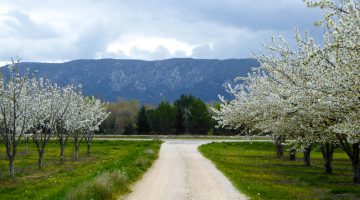Since opening in 2012 the stunning video art show at Carrières de Lumières has entranced millions. Situated just steps from the medieval perched village of Les Baux-de-Provence each year, the work of the Masters is splashed across the cavernous walls of this former bauxite quarry. This year, ‘Van Gogh, La Nuit étoilée’ pays tribute to one of the world’s greatest artists, Vincent Van Gogh (1853-1890).

From a selection of about 500 paintings, Carrières de Lumières’ talented artistic directors Gianfranco Iannuzzi, Renato Gatto and Massimiliano Siccardi, showcase Van Gogh’s incredible genius. His story is told across the quarry’s 7000 square meters of walls, many of which loom over 15 meters high. Starting from the sun-drenched wheat fields of Arles, to Paris and then back to Provence, from where Van Gogh strove tirelessly to capture the light and colours of this region which so bewitched him.

“Van Gogh is one of the most important painters that ever lived. The exhibition produced for Carrières de Lumières highlights the artist’s unique approach. We realised it was important to show the thickness of the paint medium and the impact of colors, and focus on the decisiveness of the brushstrokes and use of line, all of which are so characteristic of Van Gogh’s works” Gianfranco Iannuzzi

As in the preceding performances there is an enthralling accompanying exhibit. This year’s ‘Dreamed Japan Images of the Floating World’ profiles art from the land of the rising sun which inspired Van Gogh profoundly.

Vincent Van Gogh’s childhood
Born in Groot Zundert in the Netherlands in 1853, Vincent Van Gogh was the eldest of six children. Inspired by his father who as a pastor used imagery to illustrate his sermons, Van Gogh began painting as a young child. Difficult, shy and socially awkward he left school at 16 and went on to work at art galleries in the Hague, Brussels, London and Paris.,
Van Gogh the young artist
During his time in London and Brussels, distressed by the plight of the poor and sick, this troubled young man sought to find his soul in painting. His work from then reflects the sorrow he felt for the disenfranchised.

The Potato Eaters ~ Vincent Van Gogh
In 1880, at the age of 27 Van Gogh enrolled at Academie Royale des Beaux-Arts in Brussels. From here he began to paint in earnest, initially mostly landscapes and then scenes from every day life. After his father’s death in 1885 his paintings became more liberated and he began ‘to paint what I feel and feel what I paint.’ (Vincent Van Gogh)

Van Gogh in Provence 1888 -1889
Wishing to escape hectic city life, in February 1888 Van Gogh moved to Arles, Provence. Initially he lived in a room at Café de la Gare before moving to the La Maison Jaune. Surrounded by the natural light and colours of Provence Van Gogh found the perfect place to develop his talents.
His use of bold colours and powerful brushstrokes demonstrates the dialogue he saw between light and shadows. Expressed dramatically in the multi-coloured petals of one of his most famous pieces, The Sunflowers, les Tournsoles, flowers which are still so synonomous with Provence and which he painted both in full bloom and dying.

‘The Sunflowers’ ~ a series of three paintings, 1888.

The sunflowers at Carrières de Lumières.

During his time in Arles Van Gogh became fascinated by the local people which he considered to be so different from elsewhere.

Turbulent Housemates by Van Gogh
From Arles he continued to develop his unique treatment of light, depicted most famously in Terrasse de café le soir, Le café de nuit, La Maison Jaune and La Chambre.

La Chambre ~ Vincent Van Gogh
Brilliantly capturing the beauty of Provence within which he’d immersed himself, Van Gogh’s work also continued to reflect the intensity of his thinking and his inner torment. The turmoil he saw and then painted in nature perhaps mirrored his own anguish, illustrated in the sublime but ominous atmosphere of the sky in Nuit étoilée sur le Rhône (1888) and La Nuit étoilée (1889).

La Nuit étoilée ~ Vincent Van Gogh
His paintings of the olive and cypress trees (1889) also show this chaos he saw in natural beauty.

After a brief collaboration with Paul Gaugin, who joined him in Arles, Van Gogh’s unbalanced mind led him to cut off his own ear.

He was treated locally and again several times afterwards suffering from insomnia and hallucinations. Finally in May 1889 he admitted himself to Saint-Paul-de-Mausole, an asylum for the mentally ill in nearby Saint-Rémy-de-Provence. He stayed there for a year still continuing to paint hoping to find solace in his work.

Van Gogh’s paintings of the interior of Saint-Paul-de-Mausole asylum
Van Gogh’s irises painted during his stay at the Saint-Rémy asylum

During his time at the asylum Van Gogh also completed a series of self portraits.

His omin0us stare and the use of robust brushstrokes and intense colors mirror his agonized emotional state.

In May 1890, his health still extremely fragile, Van Gogh left Saint-Rémy and moved to Auvers-sur-Oise where he lived over a café. From here he famously painted the local church.

L’église d’Auvers-sur-Oise, vue du chevet by Vincent Van Gogh
Carrières de Lumières’ ‘La Nuit étoilée’ ends with one of Van Gogh’s last works ‘The Wheat Field with Crows’ (1890). Immersed into major landscapes he tried to capture the order of nature painting a threatening sky which contrasted sharply with the gold hues of a wheat field.

Unable to reconcile his increasingly disturbed state of mind on 27 July 1890 Van Gogh tragically shot himself. He died two days later never understanding his own genius or the fame that his incredible work would achieve. His astounding talent in over 2000 works remain on display as part of priceless collections around the world, magnificently portrayed in this year’s spectacle at Carrières de Lumières.
If you’d like to learn more about Van Gogh there are countless places you can visit, the Van Gogh Museum in Amsterdam is a good place to start.
Visiting Carrières de Lumières
Location: 800m from the enchanting perched village of Les Baux de Provence
Route de Maillane 13520 Les Baux de Provence
Tel: +33 4 90 54 37 Email: message@carrieres-lumieres.com
By road: Motorway A7 (exit Avignon), A9 (Nimes) and A54 (Baux-de-Provence) 10 minutes from St Remy-de-Provence, see the map below
Open: 9.00am -6.00pm, (later in summer months) 7 days a week from March – January Check website for details, re-opening March 2020
Admission: 13 Euros, family and other discounts available. Booking online advance is recommended
Tips for visiting Les Baux & Carrières de Lumières
Combine the entrance ticket with entrance to the Chateau ruins of Les Baux for a fascinating self-guided audio tour transporting you back to the time of knights and swash buckling heroes.
Don’t miss the video film of a helicopter ride over Provence, shown in the small chapel near the exit.
Eat elsewhere, in nearby St Remy-de-Provence, Maussane-les-Alpilles, Maussane-les-Alpilles or Arles, the Les Baux dining choices are disappointing.
If you have time, visit one of the many olive mills and wine domains in Valley Le Crau and the Roman road Via Aurelia below Les Baux on your departure.





What fabulous pictures. We so enjoyed the last 2 exhibitions but this one looks as if it tops it all.
Inspirational artist! and an amazing installation, rent Caroline’s lovely home and visit – I have been in early Autumn and it is wonderful.
Kate
Come and stay soon!
Love this post. Such beautiful photos. So glad I could see this exhibition this year. Hope to see you again somewhere in France.
Thank you for this wonderful trip through Van Gogh’s art and his state of mind as he went about making them. Still shocks me that he created all his art in the span of 10 years.
I think you might enjoy this documentary 🙂 An investigation into his time at the asylum & his rocky relationship with Gaugin. Very interesting.
https://m.youtube.com/watch?v=AgMBRQLhgFE
Thank you Zeenat and for introducing me to Nanou, she’s a peach!
This was a great show! I love Carrières de Lumières.